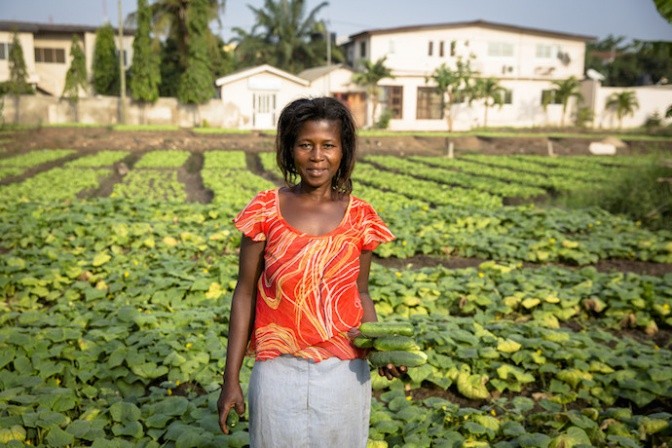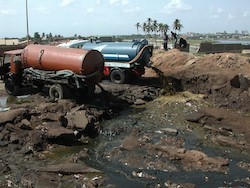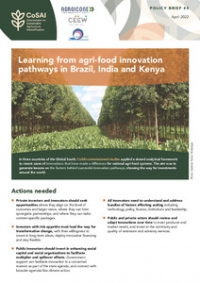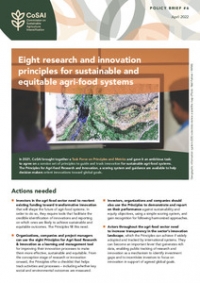Sustainable intensification is a nice phrase. But can it feed the world? Yes it can, argued Jeremy Bird, Director General of the International Water Management Institute (IWMI), at a water summit in London this month.
The conference heard more than a dozen speakers on the world’s emerging water crisis. But for Bird it was, in most places, a crisis of management rather than of absolute water shortages -- of not making the most of clean water, and of profligate disregard for the value of waste water.
 Vegetables grown using safe wastewater reuse practices in Ghana. Photo: Nana Kofi Acquah/IWMI
Vegetables grown using safe wastewater reuse practices in Ghana. Photo: Nana Kofi Acquah/IWMIWater mis-management?
Industrialists spoke of a 40-per-cent deficit opening up in the world’s water budget by mid-century, as demand for protein production from agriculture increased in areas where rivers are already running dry and water tables plunging.
But, Bird said, huge amounts of water taken from nature for irrigation never reach plant roots. This was a huge waste when simple management improvements like levelling fields, more precise furrow irrigation and drip and sprinkler irrigation systems could make dramatic savings – often allowing more crops to be grown, and raising yields. Research showed that, with the right incentives, greater water productivity could fill the 40 per cent deficit, he said. “Agriculture’s water footprint could be frozen, and even diminished.”
Some places are showing the way. The western Indian state of Gujarat has a well-told story of past overpumping of groundwaters. But initiatives such as rationing electricity supplies for pumping have improved water productivity so much in the past decade that water tables are recovering, while at the same time contributing to an annual increase in agricultural output currently estimated at 8 per cent.
Elsewhere, water goes untapped. In eastern India, there is still annually recharged underground water that farmers are not using, he said. And in Africa large reserves of groundwater go underexploited, and sometimes unexplored. The question in such places is how to exploit the renewable resource without triggering the anarchy of over-exploitation seen in so many other places.
The unexploited asset: fecal waste
Clean water is only half the story, however. Dirty water too has a huge value. But it often goes unexploited or is used unsafely. “Fecal waste is an asset, fully of nutrients,” Bird said.
 Unsafe disposal of sewage in the coastal areas of Ghana. Photo: Liqa Raschid-Sally
Unsafe disposal of sewage in the coastal areas of Ghana. Photo: Liqa Raschid-Sally
In some places, raw sewage from urban areas is being tapped by farmers, as a source of both irrigation water and free fertiliser. Or they buy the contents of septic tanks. But that is often a health risk to both the farmers and the consumers of their crops. “Estimates suggest that around 90 per cent of perishable vegetables grown in African cities are fertilised with waste water,” Bird noted.
Rather than trying to ban the practice, it made more sense to make it safe. “We should be turning sewage sludge into pellets for safe organic fertiliser,” he said. The nitrogen and phosphorus was far too important to be allowed to go to waste, especially when it created pollution hazards in the wider landscape.
There were health issues, he agreed. And sometimes there was cultural resistance. Cost could also be a problem. When IWMI studied more than 60 places where technologies to produce sewage pellets had been tried, “only a handful seemed to be viable without external support.” There were high transport costs, and heavily subsidised chemical fertiliser was often cheaper. But success would be a huge prize.
A new gold standard: the non-sewered toilet
Much of the conference focussed on how to integrate thinking about managing sewage and water supplies – and particularly how to achieve that in the upcoming UN sustainable development goals (SDGs).
Brian Arbogast, head of sanitation at the Bill and Melinda Gates Foundation, said efforts under the previous millennium development goals (MDGs) to dramatically cut the number of people without access to improved sanitation may have been successful in providing latrines, but had not always reduced the risks to urban environments.
In Dhaka, the capital of Bangladesh, 99 per cent of the population now had access to toilets, he said. It was an apparent triumph for the MDGs, but only 2 per cent of the waste excreted into these millions of toilets was being treated. Most of the rest eventually entered the environment.
“Septic tanks everywhere overflow -- into the yard, the lane, creeks and the neighbourhood,” he said. And if toilets were connected to sewers, then usually either the sewers leaked or the treatment works overflowed. Almost all of the city’s sewage was now reaching water courses and ponds, polluting the landscape and threatened human health – often even more than the open defecation it replaced.
Would the same mistake be repeated in India – the world capital of open defecation? Some feared so, since the new Indian prime minister, Narendra Modi, has promised to install one new toilet every second for the next four years. That was admirable, but there had to be a strategy for what happens to the waste after it enters the latrine.
What is needed, says Arbogast, is a global effort to prevent all forms of untreated fecal waste being released into the environment. The new SDGs should measure success in sanitation by that simple standard. “It would be a tragedy if that is not done,” he said.
In much of the world, meeting that target would require forgetting altogether about installing flush toilets and extending sewerage systems, Arbogast argued. The Gates Foundation -- which funds some work on resource recovery and reuse for the CGIAR Research Program on Water, Land and Ecosystems (WLE) -- was looking for “a non-sewered gold standard” for future toilets, he said. There could soon be a billion-dollar industry in providing free-standing units that required no water or electricity, and which discharged no waste – other than a fertiliser product “you can spread onto your garden”. Or your field.
The goal is to save water, improve health, protect the water environment, and recycle sewage into a cheap, safe fertilizer. “To turn shit into gold”. Why not?














